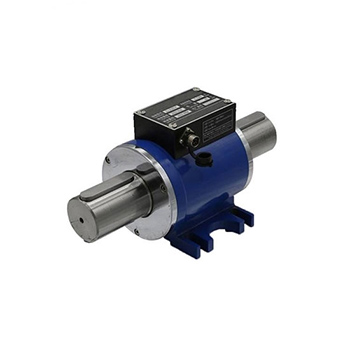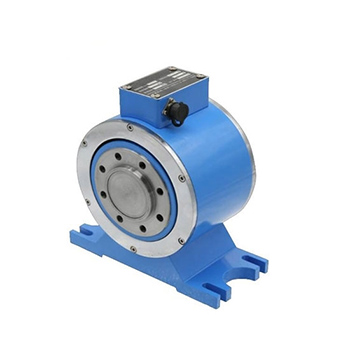What are the Types of Torque Sensor?
Torque sensors, also known as torque meters, are divided into two categories: dynamic and static. Dynamic torque sensors can also be called torque sensors, torque speed sensors, non-contact torque sensors, and rotational torque sensors, etc. Today we will introduce two types of torque sensor. We hope that after reading this article, you can have a better understanding about a torque sensor.
Non-contact torque sensor
If you want to know what a non-contact torque sensor is, you need to understand how it works.
The input shaft and output shaft of the non-contact torque sensor are connected by a torsion bar, the input shaft is provided with splines, and the output shaft is provided with a keyway. When the torsion bar is twisted by the rotational moment of the steering wheel, the relative position between the splines on the input shaft and the keyway on the output shaft is changed. The relative displacement of the spline and the keyway changes by an amount equal to the twist of the torsion bar, which changes the magnetic induction on the spline. The change of the magnetic induction is converted into a voltage signal through the coil.
Due to the non-contact working method, the non-contact torque sensor has a long life, high reliability. It is not easily affected by wear and it has a smaller delay. The non-contact torque is less affected by the deflection of the shaft and axial offset. It has been widely used in car segment.
Among the non-contact torque sensors, the most commonly used are strain-type, magneto-electric, fiber-optic and photoelectric sensors. Now, let’s introduce them briefly.
Strain-type contactless sensors utilize wireless transmission technology. With the advancement of science and technology and the development of wireless transmission technology, the conductive slip ring and brush arm used for the output signal of the contact strain gauge sensor have been replaced by wireless transmission modules. Thus it overcomes the wear between the conductive slip ring and the brush arm and improve the measurement accuracy.
The magneto electric torque sensor uses the principle of magneto electric conversion to analyze the phase difference of the two output electromotive force signals, so as to achieve the purpose of measuring torque. It can mainly divided into closed magnetic circuit sensors and open magnetic circuit sensors.
The optical fiber torque sensor mainly uses the principle of light reflection and phase difference to read the optical signals reflected from the corresponding two positions on the shaft and calculate the phase difference, so that the corresponding torque value can be calculated. However, the optical fiber sensor is easily affected by the environment, and it is relatively difficult to install and debug.
The photoelectric torque sensor takes the photoelectric sensing element as the core component. When torque is loaded on the drive shaft, the intensity of the light emitted by the light source will change accordingly, so that the output current of the photoelectric element will change. By measuring this change, the torque value can be calculated.
Rotary torque sensor
Now, let's introduce a rotary torque sensor to you, you need to understand its characteristics.
Torque sensors are the detection of torsional torque sensing on various rotating or non-rotating mechanical components. Torque sensors convert physical changes in torque into precise electrical signals. Rotary torque sensors can be used in the manufacture of viscometers, electric (pneumatic, hydraulic) torque wrenches. It have the advantages of high precision, fast frequency response, good reliability, and long life.
Rotational torque measurement: Using strain gauge electrical measurement technology, a strain bridge is formed on the elastic shaft, and the electrical signal of the elastic shaft being twisted can be measured by supplying power to the strain bridge. After the strain signal is amplified, it is converted into a frequency signal proportional to the torsional strain after pressure/frequency conversion.
Features
- The waveform of the signal output can be arbitrarily selected - square wave or pulse wave.
- High detection accuracy, good stability and strong anti-interference.
- No need for repeated zero adjustment; continuous measurement of positive and negative torque.
- It can measure static torque and rotating torque.
- Small size, heavy sensor can be used independently from the secondary instrument, as long as the +15V, -15V (200mA) power supply is provided according to the pin number of the socket. It can output an equal square wave or pulse wave frequency signal whose impedance is proportional to the torque. Lightweight and easy to install.
- Measuring range: 0-10000Nm standard optional, non-standard 20,000 Nm, 30,000 Nm, 50,000 Nm, 80,000 Nm, 100,000 Nm, 150,000 Nm, 200,000 Nm, 500,000 Nm, 1 million Nm, 2 million Nm can be customized, special range customization.
Pros and Cons
Next we will introduce the pros and cons of torque sensors, you will know that buying a torque sensor is a wise choice.
With the continuous improvement and development of the automatic control system, higher requirements are put forward for the accuracy, reliability and response speed of the torque sensor. Torque sensors are showing the following development trends:
- The test system develops in the direction of miniaturization, digitization, intelligence, virtualization and networking.
- Development from single function to multi-function, including self-compensation, self-correction, self-adaptation, self-diagnosis, remote setting, state combination, information storage and memory.
- Develop towards miniaturization and integration. The detection part of the sensor can be miniaturized by rational design and optimization of the structure. The IC section can integrate as many semiconductor components and resistors as possible into a single IC component, reducing the number of external components.
- From static testing to dynamic online testing.
Insufficiency
The success of the telemetry torque meter lies in overcoming two defects of the electric slip ring, but there are also three shortcomings:
- It is susceptible to the interference of electromagnetic waves on the site.
- Since it is battery powered, it can only be used for a short period of time.
- Due to the additional structure on the rotating shaft, it is easy to cause the dynamic balance problem at high speed, which is more prominent when the shaft is small in range and diameter.
Besides that, there is digital torque sensor. And the digital torque sensor absorbs the advantages of the above methods and overcomes its defects. Two sets of resolvers are designed on the basis of the strain sensor to realize the non-contact transmission of energy and signals. And the transmission of the torque signal has nothing to do with the rotation or not. It has nothing to do with the size of the speed and the direction of rotation. If you want to know more, please click ATO.com.

